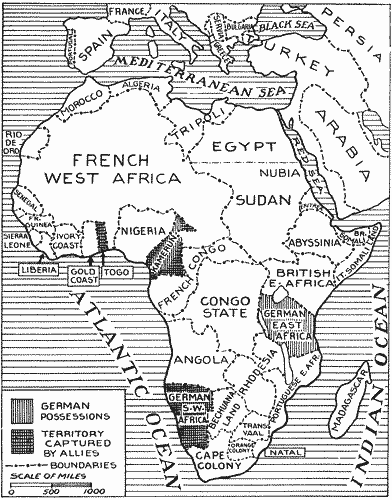|
|||||||||
|
|
The War in Africa and in the ColoniesThis section deals with the war in Africa. In the late 1800s the major powers of Western Europe - Britain, France, Germany, and Italy - scrambled to occupy large territories in Africa. The Native tribal kingdoms armed mainly with primitive weapons or at best obsolete rifles could not withstand the industrialized might of the Europeans armed with gatling guns and cannons and as a result, all of the European powers, and especially France and Britain acquired enormous sections of Africa.  German Colonies in Africa Each empire sought to establish spheres of influence and to dominate strategic territories and resources. Imperial rivalries brought the Great Powers to the verge of war on a number of occasions as the competing empires sought to absorb more and more African territory. Britain dreamed of a continuous empire stretching from the Nile Delta of Egypt all the way to the Cape of Good Hope in South Africa. Its goal was to connect all of its African colonies by a transcontinental railway. The German Empire was not as successful in establishing a large African empire. Its possessions were not contiguous, and they were underdeveloped. There were no long distance railways, and few German colonists actually settled in the African colonies. At the start of World War 1, the German empire in Africa consisted of Cameroon, Togo, South-West Africa, and German East Africa (present day Cameroon, Togo, Namibia, Tanzania, Zambia, Mozambique). The german colonies in Africa possessed few troops and had inadequate equipment. When the First World War started, Great Britain immediately attacked the German colonies in Africa, and conquered three of the four colonies in lightning campaigns. Only German East Africa (modern-day Tanzania, Burundi, and Rwanda) withstood the British attacks and held out for the duration of the war. The defence of German East African was organized by Colonel (later General) Lettow-Vorbeck. Despite being vastly outnumbered, Lettow-Vorbeck, fought a maginificent guerilla campaign for the rest of the World War 1. His defence of German East Africa had little impact on the outcome of the war, but he kept his army intact and fought a guerrilla campaign for the duration of the Great War, and he did succeed in tying up large numbers of British and colonial forces General Lettow-Vorbeck's successes became legendary and captivated the attentions of the German public, eager for good news after defeats on the Western Front. An attempt was made to supply the German forces in East Africa by sending a zeppelin with a cargo of machine guns and ammunition. However the war ended before the zeppelin could reach its destination, and the crew of the dirigible turned back for Germany. After the war Britain and France divided Germany's African empire between them. Texts and Resources About World War 1 Campaigns in Africa
| ||||||||
